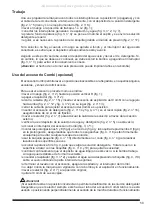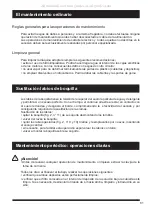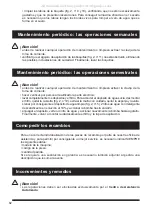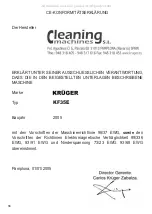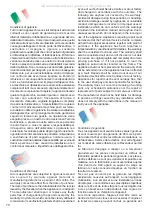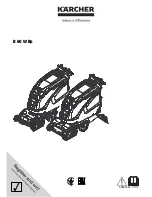
62
¡Atención!
antes de realizar cualquier operación de mantenimiento o limpieza extraer la clavija de la
toma de corriente.
verificar que el agujero de aspiración de las boquillas (fig. 2, n° 11) no está obstruido, eliminando
las posibles incrustaciones de suciedad. Finalmente, lavar las boquillas.
¡Atención!
antes de realizar cualquier operación de mantenimiento o limpieza extraer la clavija de la
toma de corriente.
hacer verificar por personal cualificado la parte eléctrica;
lavar completamente los depósitos y el filtro. Para acceder al depósito de agua sucia, desmontar
el filtro, quitar la cubierta (fig. 2, n°19), extraer la malla con cuidado, quitar la esponja y lavarla.
Llenar por consiguiente el depósito de agua limpia (fig. 2, n° 5), 2 litros de agua con detergente
descalcificante en solución al 10% y accionar la bomba hasta vaciarlo;
enjuagar el depósito, verter un litro de agua y accionar nuevamente la bomba hasta agotarlo.
Finalmente, volver a montar cuidadosamente el filtro y la tapa de aspiración.
Para una correcta individualización de las piezas de recambio por parte de nuestra oficina de
asistencia y para permitir por consiguiente un mejor servicio, es necesario indicar SIEMPRE
los siguientes datos:
modelo de la máquina;
código de la pieza;
cantidad pedida.
Si se requiere una sustitución en garantía, es necesario también adjuntar al pedido una
descripción que resuma la avería.
¡Atención!
Las reparaciones deben ser efectuadas exclusivamente por el
Centro de Asistencia
Autorizado
.
limpiar los labios de la boquilla (fig. 2, n° 9 y 10), verificando que no estén excesivamente
gastados y que no presentan laceraciones. Para conseguir la máxima eficacia en el secado
es necesario que los labios tengan los bordes vivos para romper el velo de agua que se
forma en el suelo.
Mantenimiento periódico: las operaciones semanales
Mantenimiento periódico: las operaciones semestrales
Como pedir los recambios
Inconvenientes y remedios
19
If the floor is particularly dirty and difficult to clean, wash and dry the floor in two distinct stages.
Pre-wash:
Switch the main switch and the water switch (fig. 3, no. 7 and 3) to position I (on), switch
off the vacuum switch (fig. 3, no. 2) and press the trigger down completely. Thoroughly wash the
dirtiest areas. When a sufficient amount of detergent has been spread on the floor, switch off the
water switch (fig. 3, no. 3), and continue to scrub. This gives the detergent enough time to chemically
detach and trap stubborn dirt and then allows the brushes to mechanically scrub the dirt away.
Drying:
Switch on the vacuum switch (fig. 3, no. 2) and run the appliance over the area that has
just been washed.
To wash and dry simultaneously, activate the brush, water dispenser and vacuum at the same time.
Do not remain in the same place while the brush is turning.
To dry the floor more accurately, disconnect the pump (switch 4, fig. 3) and use the brush and vacuum
functions only.
To get the most out of the floor scrubber-drier, choose the straightest possible route to clean. Any
inaccessible areas can be quickly cleaned later using a mop (or cloth) or, even better, the Combi
accessory.
The floor scrubber-drier is designed to wash and dry smooth floors which are both even and
free of any obstacles. A power supply cable is available.
The scrubber-drier distributes a suitable amount of detergent solution on the floor. It then scrubs
the floor to remove any dirt. By choosing the most suitable cleaning detergent, and thanks to
the possibility of assembling brushes made of various materials, the appliance can be adapted
to the most varied floor and dirt combinations. It can also be used to clean and polish floors.
A liquid vacuum cleaner system is built into the scrubber-drier which allows the floor to be
perfectly dried in both directions just after it has been washed. The drying blade (fig. 2, no. 10)
is dish-shaped to help collect the dirty water.
The main parts of the appliance are:
water and detergent solution tank
(fig. 2, no. 5) used to contain and transport the clean
water and cleaning product mixture;
recovery tank
(fig. 2, no. 6) collects the dirty water vacuumed off the floor during washing.
It can be removed and used like a bucket to carry and discharge the dirty water;
squeegees
(fig. 2, no. 9, 10 and 11) used to wipe and dry the floor by scraping the water off
the surface;
roller brush
(fig. 2, no. 8) mechanically removes any dirt from the floor.
Advice on how to make the best use of the floor scrubber-drier
General features
All manuals and user guides at all-guides.com












